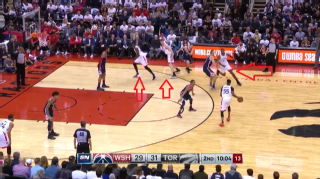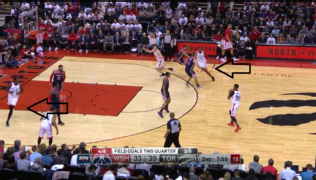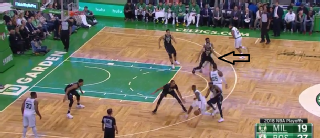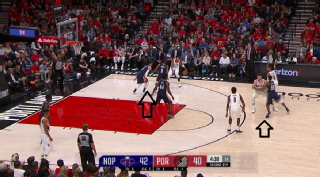|
There are layers to coaching an NBA team. The foundational stuff is the most important -- establishing a set of values, living them out, and fostering an environment in which players (and everyone else) learn and grow in service of a greater good. You won't make much progress in the nitty-gritty of teaching without that sort of infrastructure. Some coaches can't figure that part out. Some don't get time. But in the playoffs, the little things take precedence. Matchups and adjustments matter more. If your coach can't hang, you are at a severe disadvantage. With that in mind, let's look at how one set has rippled across three playoff series -- and perhaps more by the time you read this. Within seconds of CJ Miles stepping on the court in Game 1 in Toronto, it was clear Scott Brooks had given the Washington Wizards a directive: Miles gets no airspace. When Miles flew off a screen from the Toronto Raptors' center -- a classic ploy to spring a sharpshooter -- the big fella guarding the screener lunged at Miles, effectively trapping him:  That trap should give the screener -- Jakob Poeltl -- a free lane to the rim. On that play, it didn't. Pascal Siakam had also just set a screen for Miles. He lingered nearby. So did his defender (Mike Scott). No dice. C.J. Kilometres-related crisis averted. Two minutes later, the Raptors ran the same play -- only look where Siakim was:  Poeltl gets an easy lob. Andrew Bogut probably snagged two dozen alley-oops like this over four seasons screening for Klay Thompson. It's easy to say Scott should have seen the play coming, abandoned Siakam early, and barricaded the rim. It's harder to do that in real time when the offense moves the chess pieces around. And once more, in the fourth quarter:  Siakam is on the other side again, though perhaps not as far from the rim as the Raps would like. Scott has his eyes on Poeltl, ready to cut him off. Bad news: Poeltl knows Scott is coming, and drops the ball to Siakam before the Wizards can react. Whose fault is that? Bradley Beal could leave Kyle Lowry in the corner to rush at Siakam, or at least scream at him to see if he gets distracted. But that would leave Lowry open -- unless Tomas Satoransky zips down from Delon Wright at the top of the key and covers Lowry. Satoransky seems to motion for that chain of events in a brief post-basket chat with Beal. Wright is a much worse shooter than Lowry, and he's farther from the rim. Perhaps Satoransky could skip the middleman and crash down on Siakam himself. That is a lot to ask considering where Wright is, and that he had the ball -- commanding Satoranky's attention -- about two-and-a-half seconds before Siakam's hands hit the rim. Basketball is hard. But that isn't even the play we're here to discuss! Dwane Casey knew going into Game 2 that the Wizards would trap Miles, and that they would be more prepared for all the tic-tac-toe action the Raptors unleashed in Game 1. His solution: remove the second defender. DeMar DeRozan -- playing perhaps the greatest all-around game of his life, considering the stakes -- kicks off the action with a rote pick-and-roll. That is a decoy. The Wizards have mixed up their pick-and-roll coverages in this series -- from blitzing, to dropping, to going under picks, to standing comatose, or just falling over or running into each other. But the Raptors know if there is one situation in which a Washington big man might hang back it is this one: the lumbering Ian Mahinmi corralling midrange royalty. And indeed: Mahinmi retreats below the foul line.  That becomes a problem when Poeltl veers across the 3-point arc and into a sudden pick for Miles. Mahinmi is toast:  Miles misses, but Mahinmi's panicked sprint toward him frees Poeltl for an offensive rebound. Almost every team has at least toyed with that set. LA Clippers coach Doc Rivers ran it all the time with DeAndre Jordan screening for Chris Paul, and then darting over to do the same for JJ Redick. The Cleveland Cavaliers use it to jar Kyle Korver loose (like they did last night). But you can't overuse it. Timing is everything, especially in the playoffs. Casey and his staff toggled through a bunch of effective precursors, and sprung this bad boy at the right moment. Casey has been pigeonholed as a genial culture-builder. He has had some disappointing X's-and-O's moments in the playoffs. Every coach has. He has to take some of the blame for Toronto's failure to evolve on offense until management essentially mandated it. So do lots of other people. Casey has grown as a playoff chessmaster. He's due some credit for that. Brad Stevens is as good as it gets, and the Boston Celtics ran a variation of that same set in their own Game 2 win over a clueless, dispirited Milwaukee Bucks team: The skeleton is the same: Boston runs a Terry Rozier-Greg Monroe pick-and-roll designed to nudge Monroe's man -- John Henson -- down toward the paint. Monroe then shuffles over to trigger the real play: an off-ball pick for Jaylen Brown, manufacturing points for Boston in just about every possible way.  Stevens adds a cruel twist to make sure this flummoxes the Bucks -- Brown sets his own pick for Marcus Morris before looping up to catch Rozier's pass:  If Brown's pick hits, his man -- Malcolm Brogdon -- might pause in the paint to make sure Morris doesn't scamper open to the rim. That would give Brown even more daylight upon the catch. Even if the Bucks switch, as they do here, pulling that switch and then navigating another screen (Monroe's) in a literal instant is advanced NBA defense. Jabari Parker does not play advanced NBA defense. Stevens didn't invent this wrinkle, by the way. A few NBA coaches have used it. The Chicago Bulls' Fred Hoiberg leaned on it perhaps more than anyone to pop open Lauri Markkanen, and it always seemed to work: There is delicious irony in Stevens weaponizing this against Milwaukee. Under Jason Kidd and now Joe Prunty, the Bucks famously trapped and swarmed pick-and-rolls well beyond the 3-point arc with a frenzy that has become anachronistic. Stevens was among the first coaches to use the Bucks' aggression against them. He crafted sets designed to bait them into trapping, with release valves planted around the floor. Milwaukee in this series is playing a much more conventional style, keeping its big men at the level of the screen (and often below that) and even switching (though rarely with Henson). Stevens took a game to digest that strategic shift, and leveraged Milwaukee's newfound conservatism against it. He played for Henson to drop back. That's mean. The same general set made an appearance in the Portland Trail Blazers' devastating Game 2 loss to the New Orleans Pelicans: Jusuf Nurkic screens for Evan Turner on the sideline -- kind of an odd location -- before stomping up to do the same for Damian Lillard:  Rajon Rondo snuffs Lillard's open look with a well-timed stunt away from Turner. (By the way: Wright undid so many Washington possessions in Game 2 with little slides like that. He was somehow everywhere without ever straying too far from the wrong player. He is the real-life embodiment of Toronto's old algorithmically perfect Ghost Defenders. He won't stunt away from a good shooter in the corner to disrupt a worse one stationed above the break, but he will stunt away from a so-so shooter on the wing toward a better one in the corner. Dude is a walking calculator. He knows time, score, personnel and playbook as well any perimeter defender in the league.) Rondo's rotation unlocks a Turner drive, which in turn unlocks an open triple for Al-Farouq Aminu. New Orleans long ago decided it would live with any of that over an open-ish Lillard 3. The Blazers ran this set a couple of times, with middling results. They looked a little out of sync: They have the right idea, though. The combination of Jrue Holiday and Anthony Davis is absolutely swallowing Lillard on pick-and-rolls. He can't even stretch his arms, let alone pull up for an open 3-pointer. Portland has scored just 0.4 points per possession -- not a typo -- when Lillard shoots out of a pick-and-roll, or passes to a teammate who shoots right away, per Second Spectrum tracking data. This set is a method of shoving Davis out of the picture, and cracking open more room for Lillard. Portland tried a few new things to dislodge Lillard in Game 2. They opened the game by having Nurkic and then CJ McCollum set a staggered screen for Lillard -- an unconventional guard-guard screen that trapped Davis in a forest of bodies and put a smaller defender (the guy defending McCollum) in an unfamiliar spot. They ran that play, or some cousin of it, a few times. Once or twice, they had Aminu slam Lillard's guy with a pick right at half court -- before the defense was ready, and far enough from the rim that Lillard had a long runway. They called up Solomon Hill's man to screen for Lillard, knowing Hill prefers to hedge -- and that Lillard can turn the corner. Some of it worked. In general, anytime Portland finds Rajon Rondo on Lillard instead of Holiday, they should go right into pick-and-roll mode for him. Rondo is a screen magnet. But New Orleans isn't a passive recipient of Portland's strategy. They've seen all this on film now, and they are making life very hard for Portland. Davis is obliterating things all over the floor. Put him on Nurkic, as the Pelicans did in Game 1, and he smothers Lillard and McCollum at the point of attack. Stick him on Aminu -- their gambit for most of Game 2 -- and he roves around as a one-man zone, getting in everyone's business and discarding shots at the rim with a calm disdain. The terms of engagement got smaller in Game 2 -- thanks in part to the matchup issues presented by Davis and Mirotic, working a bit as a small-ball center. Nurkic logged just 15 minutes. Zach Collins spent most of his time at center, though he's not a good enough shooter for New Orleans to care -- or abandon their blitzing of Portland's star guards. With Maurice Harkless back, we briefly saw Aminu at center. Portland got smaller, and switchier. They slotted Aminu and Harkless on Davis and Holiday precisely to switch that two-man action. Problem is, the smaller Portland gets, the more the Pelicans can switch, too. And they will eventually realize they are allowed to get the damned ball to Davis in the post when Aminu is on him. These little things make the playoffs fun -- and an entirely different game from the regular season. We'll see more variations on this pet set soon -- and loads more strategic back-and-forth. Buckle up.
|

